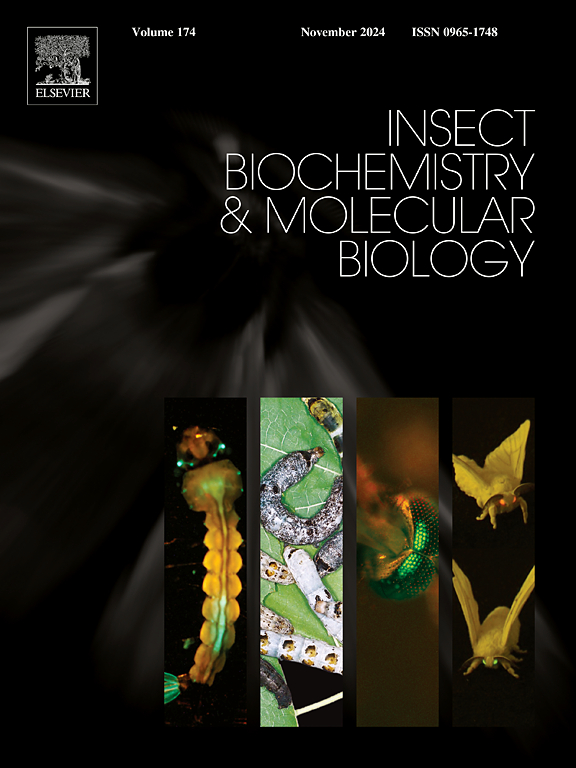β2-tubulin and its promoter in the brown planthopper: A versatile tool for genetic control strategies
IF 3.2
2区 农林科学
Q2 BIOCHEMISTRY & MOLECULAR BIOLOGY
引用次数: 0
Abstract
At present, the application of CRISPR/Cas9 technology for genetic manipulation in insects is predominantly concentrated on Diptera model species, including Drosophila and mosquitoes. In contrast, non-model insects such as the brown planthoppers (BPH, Nilaparvata lugens), a major insect pest of rice, have received less attention in genetic manipulation due to insufficient tools. Here, the analysis of spatiotemporal expression patterns revealed that β2-tubulin in BPH (NlB2t) was predominantly concentrated in male adults and male testis, exhibiting high expression levels. Knockdown of NlB2t expression by using RNAi resulted in the obstruction of male testis development. Mating between the RNAi-treated males and wild-type females led to a notable reduction in the number of eggs laid and the hatching rate of those eggs by 58.2% and 50.6%, respectively. The longevity of RNAi males significantly increased, and females that had previously mated with RNAi males exhibited a diminished inclination for re-mating with wild-type males. The dual-luciferase reporter assay demonstrated robust promoter activity in the upstream 943 bp of NlB2t, capable of driving Cas9 protein expression in vivo and effectively inducing target gene knockout. These findings elucidated that NlB2t may be a key gene in BPH male testis development and reproduction, as a promising target for sterilization. Its upstream promoter serves as a germline promoter, significantly facilitating the development of genetic control tools based on CRISPR/Cas9 technology in BPH.

褐飞虱中的β2-微管蛋白及其启动子:基因控制策略的多功能工具。
目前,CRISPR/Cas9技术在昆虫基因操作方面的应用主要集中在双翅目模式物种,包括果蝇和蚊子。相比之下,非模式昆虫,如水稻主要害虫褐飞虱(BPH, Nilaparvata lugens),由于工具不足,在遗传操作中受到的关注较少。本研究通过对BPH中β2-微管蛋白(NlB2t)的时空表达模式分析发现,β2-微管蛋白主要集中在成年男性和男性睾丸中,表达水平较高。通过RNAi敲低NlB2t的表达可导致男性睾丸发育受阻。经rnai处理的雄虫与野生型雌虫交配,产卵数和卵孵化率分别显著降低58.2%和50.6%。RNAi雄性的寿命显著增加,并且先前与RNAi雄性交配的雌性表现出与野生型雄性再次交配的倾向降低。双荧光素酶报告子实验显示,在NlB2t上游943 bp有强大的启动子活性,能够在体内驱动Cas9蛋白表达并有效诱导靶基因敲除。这些发现表明NlB2t可能是BPH男性睾丸发育和生殖的关键基因,是一个有希望的绝育靶点。它的上游启动子作为种系启动子,极大地促进了基于CRISPR/Cas9技术的BPH遗传控制工具的开发。
本文章由计算机程序翻译,如有差异,请以英文原文为准。
求助全文
约1分钟内获得全文
求助全文
来源期刊
CiteScore
7.40
自引率
5.30%
发文量
105
审稿时长
40 days
期刊介绍:
This international journal publishes original contributions and mini-reviews in the fields of insect biochemistry and insect molecular biology. Main areas of interest are neurochemistry, hormone and pheromone biochemistry, enzymes and metabolism, hormone action and gene regulation, gene characterization and structure, pharmacology, immunology and cell and tissue culture. Papers on the biochemistry and molecular biology of other groups of arthropods are published if of general interest to the readership. Technique papers will be considered for publication if they significantly advance the field of insect biochemistry and molecular biology in the opinion of the Editors and Editorial Board.

 求助内容:
求助内容: 应助结果提醒方式:
应助结果提醒方式:


